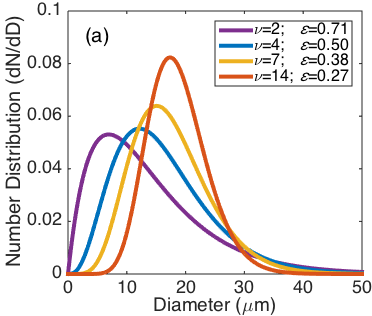Cloud Droplet Size Distributions
Clouds are composed of countless tiny water droplets. These water droplets are typically 5-50 microns in diameter and come in a variety of sizes. The distribution of sizes is quite important for a number of processes related to clouds. For example, a greater variety of sizes will generally lead to faster formation of rain-sized water drops. Even if the mean cloud droplet size is the same, a greater variety of sizes in the cloud droplet population will mean that the cloud will evaporate more slowly along its edges and be less reflective of shortwave radiation. These examples illustrate why understanding then what processes control the variety of cloud droplet sizes is important for both weather and climate.

Example distributions of droplet sizes. All distributions have the same mean diameter, but the relative numbers of large and small droplets differ which impacts everything from rain production to radiative properties of clouds. Figure 1a from Igel and van den Heever 2017b.
Our current work is aimed at understanding these processes, and how we can better represent cloud size distributions for all hydrometeor types in models. We are using a combination of observations and modeling to achieve this goal. See some of my recent publications [1, 2, 3] for more information on this topic.